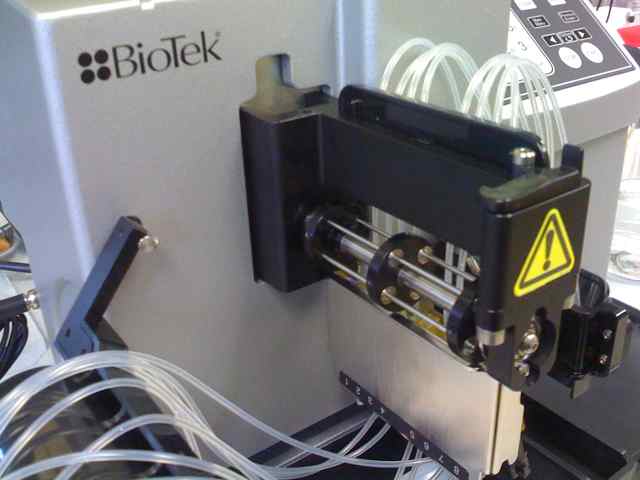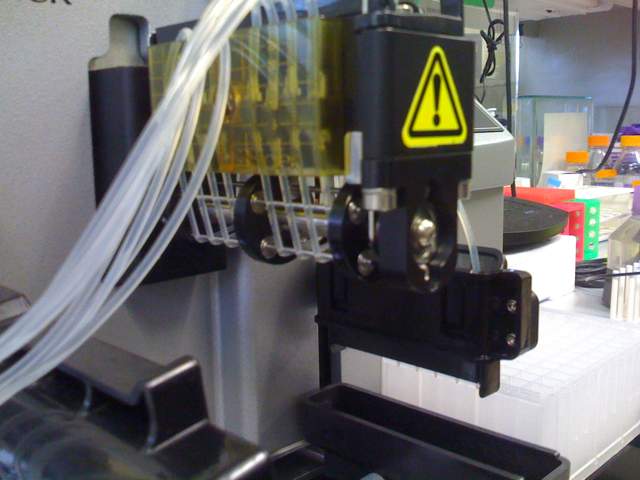Month: December 2009
Product Review: BioTek Microflo liquid dispensing machine
A couple of pictures of the BioTek Microflo liquid dispenser.
Device with hatch open and spring tension unlocked:

BioTek Microflow cartridge in place. Spring tensioner open. Eight silicone tubes run in parallel, across the pump axle.
Device with hatch open and spring tension locked:

Biotek Microflo with tensioner locked. Tension is placed across the silicone tube liquid lines. Tension is adjustable with a set screw parallel to each line (screws not shown here, they are vertical and can be seen in a top-down view). The axle rotates clockwise or counterclockwise to move liquid forward or backward with peristaltic action. It is very fast.
This machine has both serial RS-232 and USB; however, the communication link is a proprietary protocol which is only compatible with BioTek’s Microsoft Windows software. The machine is not Unix compatible. So unfortunately, I won’t be using this device in my lab automation setup.
U.S. Office of Science and Technology Policy soliciting your feedback on “Improving Public Access to Results of Federally Funded Research” until Dec 20, 2009
The U.S. Office of Science and Technology Policy, under directives from the President Obama administration, is soliciting public feedback. Note the deadline! (Dec. 10th-20th)
Policy Forum on Public Access to Federally Funded Research: Implementation
Thursday, December 10th, 2009 at 7:25 pm by Public Interest Declassification Forum
By Diane DiEuliis and Robynn Sturm
Yesterday we announced the launch of the Public Access Forum, sponsored by the White House Office of Science and Technology Policy. Beginning with today’s post, we look forward to a productive online discussion.
One of our nation’s most important assets is the trove of data produced by federally funded scientists and published in scholarly journals. The question that this Forum will address is: To what extent and under what circumstances should such research articles—funded by taxpayers but with value added by scholarly publishers—be made freely available on the Internet?
The Forum is set to run through Jan. 7, 2010, during which time we will focus sequentially on three broad themes (you can access the full schedule here). In the first phase of this forum (Dec. 10th-20th) we want to focus on the topic of Implementation. Among the questions we’d like to have you, the public and various stakeholders, consider are:
- Who should enact public access policies? Many agencies fund research the results of which ultimately appear in scholarly journals. The National Institutes of Health requires that research funded by its grants be made available to the public online at no charge within 12 months after publication. Which other Federal agencies may be good candidates to adopt public access policies? Are there objective reasons why some should promulgate public access policies and others not? What criteria are appropriate to consider when an agency weighs the potential costs (including administrative and management burdens) and benefits of increased public access?
- How should a public access policy be designed?
- Timing. At what point in time should peer-reviewed papers be made public via a public access policy relative to the date a publisher releases the final version? Are there empirical data to support an optimal length of time? Different fields of science advance at different rates—a factor that can influence the short- and long-term value of new findings to scientists, publishers and others. Should the delay period be the same or vary across disciplines? If it should vary, what should be the minimum or maximum length of time between publication and public release for various disciplines? Should the delay period be the same or vary for levels of access (e.g. final peer reviewed manuscript or final published article, access under fair use versus alternative license)?
- Version. What version of the paper should be made public under a public access policy (e.g., the author’s peer-reviewed manuscript or the final published version)? What are the relative advantages and disadvantages of different versions of a scientific paper?
- Mandatory v. Voluntary. The NIH mandatory policy was enacted after a voluntary policy at the agency failed to generate high levels of participation. Are there other approaches to increasing participation that would have advantages over mandatory participation?
- Other. What other structural characteristics of a public access policy ought to be taken into account to best accommodate the needs and interests of authors, primary and secondary publishers, libraries, universities, the federal government, users of scientific literature and the public?
We invite your comments […]
Give government your feedback on how to release data and publications from publicly funded research.
- Register for an account on the U.S. Office of Science and Technology Policy site here: http://blog.ostp.gov/wp-login.php?action=register
- Leave your policy comments on their WordPress blog!
More information is in the U.S. Office of Science and Technology Policy video:
Microplate Standard Dimensions
The mission of the Microplate Standards Working Group (MSWG) is to recommend, develop, and maintain standards to facilitate automated processing of microplates on behalf of and for acceptance by the American National Standards Institute (ANSI). Once such standards are approved by the MSWG, they are presented to the governing council of the Society of Biomolecular Screening (SBS) for approval for submission to the ANSI. Although sponsored by SBS, membership in the MSWG is open to all interested parties directly and materially affected by the MSWG’s activities, including parties who are not members of SBS.

- ANSI/SBS 1-2004: Microplates – Footprint Dimensions
- ANSI/SBS 2-2004: Microplates – Height Dimensions
- ANSI/SBS 3-2004: Microplates – Bottom Outside Flange Dimensions
- ANSI/SBS 4-2004: Microplates – Well Positions
“Meat 2.0”
In synthetic biology conferences, engineering improvements of food is listed in the top three applications of the new technology. As an example, George Church’s lab developed a genetic engineering technology specifically aimed at evolving super-tomatoes containing high amounts of the anti-oxident lycopene, as proof-of-concept. Frequent brainstorming “what could syn bio do?” sessions include ideas of growing thick beef steaks without the cow: in essence, this is presumed to be an improvement on quality, cleanliness, nutrition, and animal rights, than today’s factory-farming method of bringing steak to the table.
What if there is already a better “steak”? Let’s call it Meat 2.0. How about modifying Rhizopus oligosporus, the fungus used in making tempeh, to create new tastes or additional vitamins? Note that the below article states, “cost of preparing 1.5 kg of tempeh was less than US$1.”
Nutritional and sensory evaluation of tempeh products made with soybean, ground-nut, and sunflower-seed combinations
M. P. Vaidehi, M. L. Annapurna, and N. R. Vishwanath
Department of Rural Home Science and Department of Agricultural Microbiology, University of Agricultural Sciences, Bangalore, IndiaINTRODUCTION
Tempeh products made from soybeans and from combinations of soybeans with ground-nuts and sunflower seed at ratios of 52:48 and 46:54 respectively were tested for their appearance, texture, aroma, flavour, and over-all acceptability. In addition, tempeh was prepared with and without the addition of bakla (Vicia faba) to soybeans in various ratios to obtain a tempeh of acceptable quality and nutritional value (1). Bakla tempeh at a 1:1 ratio was found to be crisper and more palatable than plain soybean tempeh, but at 3:1 the tempeh had a mushroom odour.
EXPERIMENTS
Materials
Tempeh culture (Rhizopus oligosporus) was obtained from the New Age Food Study Center, Lafayette, California, USA. It was grown on a rice medium and inoculated while different blended tempehs were prepared. A 2.5 9 packet of culture was used for 250 9 of substrate on a dry weight basis.
Soybeans (Hardee), ground-nuts (TMV-30), and sunflower seed (Mordon) were obtained from the University of Agricultural Sciences, Bangalore. Three varieties of tempeh -100 per cent soy, soy-ground-nut (52:48), and soy” sunflower seed (46:54)-were prepared under identical conditions.
Preparation of Tempeh and Products
